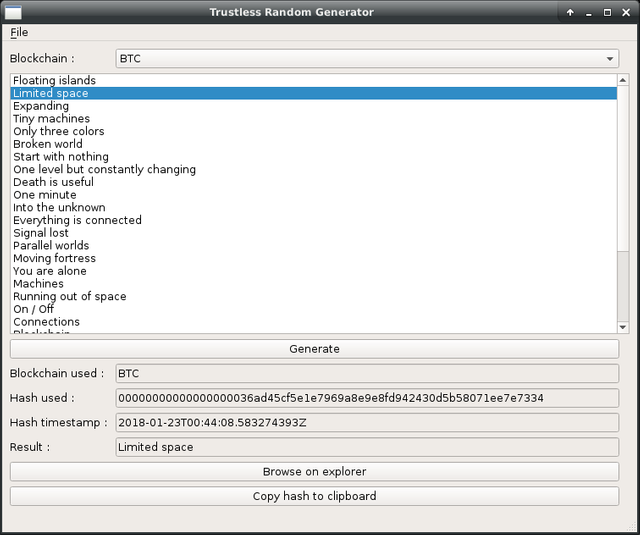Trustless Random Generator (TRG)
TRG provides a new way to pick a choice randomly without any cheating possible. It relies on blockchain technology, used by some cryptocurrencies, to generate numbers that are completely random but also verifiable by anyone.

Use case
Imagine you are organizing a drawing contest held in a limited timeframe that follows a specific theme. You will also be participating to the event. You will announce a "randomly generated" theme tonight from a list of themes at 8pm which will mark the start of the event. How can the other participants be certain that you did not cheat by picking the theme of your choice? TRG removes the "Organizer advantage" and the need of a third party to verify the integrity of the results by offering a method anyone can verify. It ensures that the organizer randomly generates the data at said time.
How does it work?
TRG uses the blockchain's immutability as a solution. The program fetches the most recent block hash that will be used as a seed for the random generation. Users can verify that the used seed was a valid hash at the moment the organizer said he would generate the data. Multiple blockchains are available such as BTC, ETH and LTC, offering different tradeoffs of possible risks.
Verifying results
TRG allows you to verify the results for a specific hash

Risks and possible malicious actions
Orphaned block (Uncommon, low risk)
What happens to results coming from an orphaned block? How do you verify the results? While this should be an uncommon situation, the participants doubting the organizer should always immediately verify the hash (preferrably by using TRG, because it will get data from the same node). This ensures that if the current chain is abandonned for another and the block generating the results is lost, the participants will already have verified the organizer's integrity.
Malicious actor rejecting a block to alter the results (Very unlikely, high risk)
A malicious actor that successfuly mines a block at the time the organizer said he would generate the data could reject his block to alter the results. While this is very unlikely, someone that would reject the reward of a block to gain some advantage is likely to have a lot at stake in the event. Unless the event rewards the winner with something much better than a block reward, this should never happen.
Open-Source
By going to the repository here, you will quickly realize I lazily copied to the readme I just wrote. (This is a secret between you and me ok). I have not put any downloadable executable just yet, because I intend of adding and fixing a few things before doing so.
SteemitJam
I already used a non-GUI version for the first edition of #SteemitJam (Game creation event held earlier this month), but this GUI version will be used for the other SteemitJams.
your secret is safe. nobody's perfect 😎
Downvoting a post can decrease pending rewards and make it less visible. Common reasons:
Submit
Nice post..i like it...thanks for sharing
Downvoting a post can decrease pending rewards and make it less visible. Common reasons:
Submit
If you can obtain significant mining mining power in a network, you can perform an attack on this kind of RNG by mining blocks and only publishing the one that will result in desired range of numbers.
Downvoting a post can decrease pending rewards and make it less visible. Common reasons:
Submit
Yes, I talk about it in the paragraph "Malicious actor rejecting a block to alter the results (Very unlikely, high risk)".
Downvoting a post can decrease pending rewards and make it less visible. Common reasons:
Submit
Ah, ok. I misunderstood the terminology there.
Downvoting a post can decrease pending rewards and make it less visible. Common reasons:
Submit